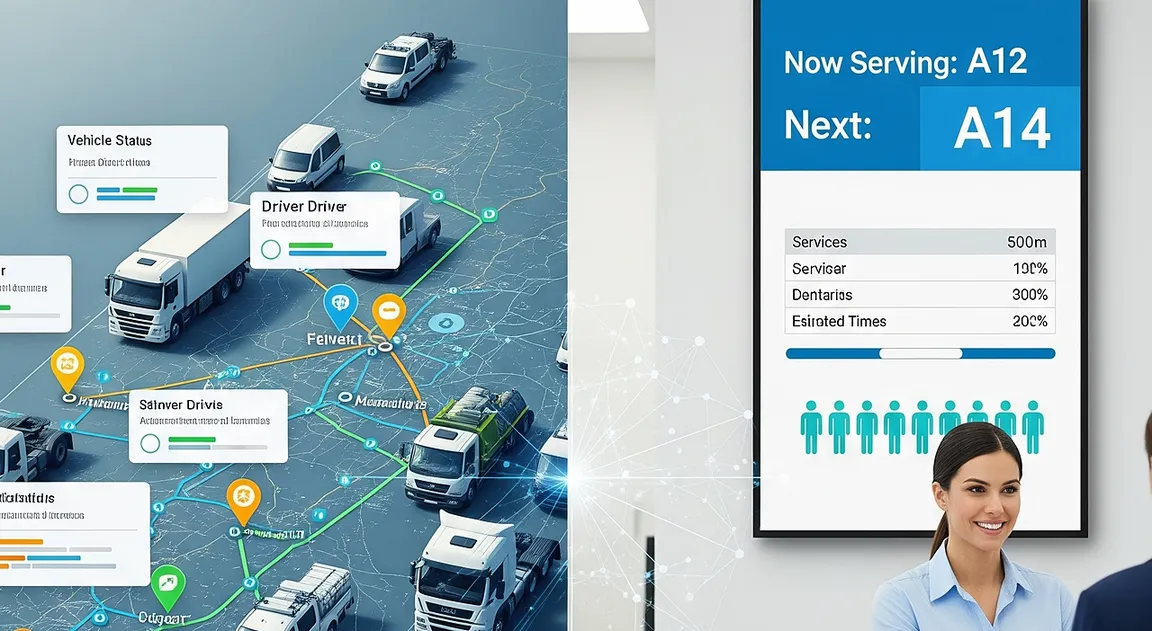In today’s fleet-driven economy, operational efficiency is no longer a nice-to-have — it’s a competitive necessity. Fleet operators across the world are investing heavily in Fleet Management Software (FMS) to plan smarter routes, reduce fuel costs, and monitor driver performance in real time. These platforms act as the strategic brain of fleet businesses, ensuring that vehicles stay road-ready and operations remain cost-effective.
The global fleet management market, currently valued at around USD 28.6 billion, is projected to reach USD 55.6 billion by 2028, according to MarketsandMarkets. This rapid growth underscores how critical efficiency, visibility, and data-driven decision-making have become to the sector.
And yet — even with all this intelligence — the biggest bottlenecks often emerge not on the road, but at depots, yards, and service centres. Trucks line up at the gate, drivers wait for hours, bays sit idle between jobs, and dispatch schedules unravel downstream.
Every minute of truck dwell time is lost productivity and lost revenue.
See how VirtuaQ eliminates depot bottlenecks → Book a Demo
Where Fleet Management Software Excels — and Where It Stops
FMS platforms are exceptional at answering strategic questions:
- Where are my vehicles right now?
- Which routes cost the most to operate?
- How can I reduce compliance risk and unplanned downtime?
With GPS tracking, predictive maintenance, telematics, and driver behaviour insights, FMS provides unmatched visibility across the route lifecycle.
However, FMS typically isn’t designed to orchestrate the fine-grained, real-time flow of assets through a depot or yard. It doesn’t decide:
- Which vehicle should enter the gate next?
- How to dynamically assign bays as they free up?
- How to manage staging areas and priority loads in real time?
And this is where the yard blind spot costs fleet operators more than they realise.
Why Depot and Yard Queues Matter for Fleet Economics
When vehicles arrive at a service centre or depot, every uncoordinated queue creates a financial ripple effect:
- Direct costs:
- Driver-paid idle hours
- Missed shifts
- Unutilized truck capacity
- Higher overtime for staff
- Indirect costs:
- SLA breaches and late deliveries
- Scheduling disruptions
- Lower asset utilisation
- Lost customer trust
The problem isn’t the vehicles — it’s how they’re orchestrated once they arrive.
Closing the Last Mile: How Virtual Queueing and Yard Orchestration Solve the Problem
A Queue Management System (QMS) fills the exact operational gap that FMS leaves open. While FMS provides intelligence, QMS like VirtuaQ provides orchestration — ensuring trucks, drivers, and bays are managed in real time with precision.
Here’s how a virtual queueing + yard orchestration flow works:
- Gate Check-In → Virtual Token
- The driver arrives and scans a QR code or is recognised via vehicle ID.
- VirtuaQ issues a digital token with an estimated wait time and staging location.
- Staging & Bay Orchestratio
- Instead of first-come-first-served chaos, VirtuaQ places vehicles in a virtual queue.
- Vehicles are automatically released to specific bays as soon as they’re ready.
- Priority Routing
- Urgent loads (e.g., perishables, express cargo, maintenance-critical vehicles) are auto-prioritised and bumped to the next available bay.
- Maintenance & Wash Scheduling
- Integration with the FMS allows vehicles flagged for servicing to be routed automatically to M&R bays once they reach the top of the queue.
- Load Handling Sequencing
- Queue data is synced with booking or manifest data, so loaders and handlers are prepped before the vehicle arrives.
VirtuaQ Capabilities at a Glance
| Capability | Benefit |
| Pooled Queues & Dynamic Assignment | Assign trucks to service pools (multi-bay depots) dynamically for faster turnaround |
| Multi-Channel Check-In (SMS / WhatsApp / QR / Kiosk) | Seamless driver onboarding and reduced gate congestion |
| Priority Rules & Auto-Rerouting | Critical loads are prioritised automatically for SLA compliance |
| FMS Integration | Maintenance routing and staging aligned with fleet plans |
| Cloud / On-Prem Deployment | Flexible setup, secure for banking or high-compliance yards |
Advantages of Queue Management + Integration Readiness
When integrated with FMS, VirtuaQ delivers tangible business outcomes:
Advantages
- Lower dwell times & higher throughput
- Better driver experience — transparent, predictable wai
- Improved prioritisation for critical loads
- Soft integration with existing systems (cloud/on-prem options)
Integration Readiness Factors
VirtuaQ is designed for rapid deployment, but a few foundational elements accelerate the process:
- Yard telemetry or operator input points for bay availability
- Defined service workflows for accurate routing
- API readiness for FMS integration
- Willingness to adopt improved gate and staging processes
The Business Case for FMS + VirtuaQ Integration
Bringing FMS intelligence and QMS orchestration together unlocks operational excellence across the entire fleet ecosystem:
- Cut depot dwell times by up to 40%
- Increase throughput without new infrastructure investment
- Improve driver satisfaction and retention by eliminating unpredictable waits
- Gain real-time visibility from the road to the bay
- Reduce costs and unlock new capacity through smarter asset utilisation
In industries like logistics, automotive, courier, and leasing — where SLAs are tight and margins are thin — this can be the difference between staying competitive and falling behind.
Conclusion: Closing the Yard Blind Spot
Relying on Fleet Management Software alone is like having a world-class GPS but no traffic signals at the depot. The real efficiency gains are made at the last mile of operational flow — where trucks, drivers, and bays intersect.
VirtuaQ’s Queue Management System closes this gap seamlessly, turning idle time into throughput, improving staff productivity, and boosting operational resilience.
Book a demo with VirtuaQ and see how easily we integrate with your existing FMS to transform your depot operations.
